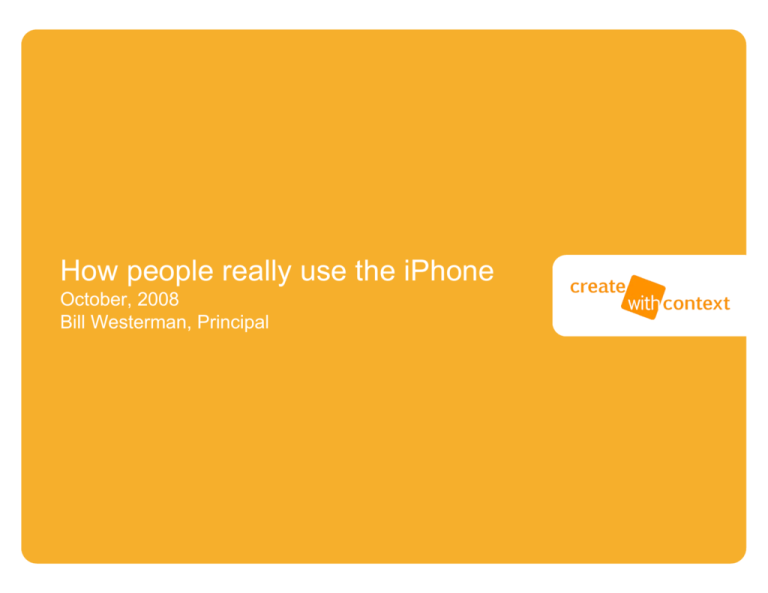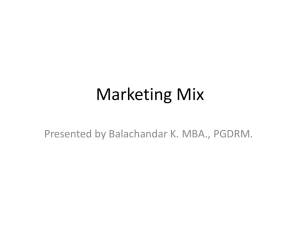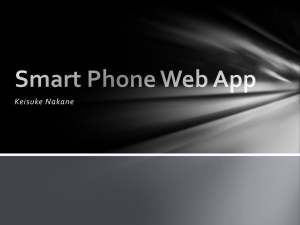
How people really use the iPhone
October, 2008
Bill Westerman, Principal
Who is Create with Context?
We are a strategic design and research firm focused on web, mobile, desktop,
and consumer electronics applications
We help companies with complex, strategic innovation projects: reinventing
existing digital products, inventing entirely new digital products, and bridging the
gap between physical products and the digital world
Consumer and business-to-business behaviors
Ecommerce and social commerce
Social media and communities
Internationalization and multi-cultural experiences
Multiplatform products (such as consumer electronics+web+ecommerce)
Clients range from the Fortune 500 to technology startups
Founded 2005, with headquarters in Santa Clara, California
Copyright © 2008 Create with Context, Inc. All rights reserved.
What we’ll talk about today:
Our research
How people really use the iPhone
Purchasing applications
Eight rules of thumb
Copyright © 2008 Create with Context, Inc. All rights reserved.
Our research
Copyright © 2008 Create with Context, Inc. All rights reserved.
Research goals
Understand how people interact with the iPhone platform
What works, what doesn’t work, and why?
Are there mismatches between expectations and platform?
Where are there usability and/or usefulness issues?
Where does the iPhone UI excel, and where doesn’t it?
Observe how the mass market - not the experts - uses the iPhone
Copyright © 2008 Create with Context, Inc. All rights reserved.
Research approach and structure
Combination of in-lab and expert heuristic evaluation
Interviewed blend participants at our Santa Clara research lab
People who currently own iPhones
People who have hands-on knoweldge of
the iPhone, but do not own one
People who had never touched an iPhone
Research focus on older, non-trendy demographic
Ages ranging from 30-55
Based on previous research, this target
market has disposable income and
purchases technology for self-consumption
Participant session structure
Funnel approach, beginning with broad interview
Followed by specific tasks and workflows
Copyright © 2008 Create with Context, Inc. All rights reserved.
How people really
use the iPhone
Copyright © 2008 Create with Context, Inc. All rights reserved.
How people really use the iPhone
As iPhone developers, it’s tempting to believe that everyone knows how to use
all of the iPhone applications and interactions
In our research, however, we found that take-up of interactions - even when
these were consistent across applications - was often quite slow
And even ‘expert’ users were not aware of the ins-and-outs of every interaction for example, our ‘expert’ participants didn’t know the two-finger single tap to
zoom out on Google Maps
Copyright © 2008 Create with Context, Inc. All rights reserved.
Browsing the New York Times website
Placement of text box
mirrors the desktop
browser, suggesting
that URLs go here
Copyright © 2008 Create with Context, Inc. All rights reserved.
Browsing the New York Times website
None of the novice
users understood the
use of the (X) button
Copyright © 2008 Create with Context, Inc. All rights reserved.
Browsing the New York Times website
And some novices
thought it was the Go
button like in early IE
Copyright © 2008 Create with Context, Inc. All rights reserved.
Browsing the New York Times website
Users quickly figured
out that they could
swipe to scroll, in part
due to clipped lines
Copyright © 2008 Create with Context, Inc. All rights reserved.
Browsing the New York Times website
“The magnifying glass
took me out of the
(New York Times) and
into Google.”
However, when they
needed to zoom, users
became confused
“There’s a book here.
Does that mean you
can read?”
Copyright © 2008 Create with Context, Inc. All rights reserved.
Browsing the New York Times website
Definitely not what
was expected
“I keep thinking the
plus sign is to make
it larger”
Copyright © 2008 Create with Context, Inc. All rights reserved.
Browsing the New York Times website
But this wasn’t what
they expected to see
Some felt this icon
would zoom them out
to the entire page
Copyright © 2008 Create with Context, Inc. All rights reserved.
Setting an alarm
All users quickly
found the Alarm
button
Copyright © 2008 Create with Context, Inc. All rights reserved.
Setting an alarm
In this instance, the
(+) was easy to find
The spinning dials
were relatively intuitive
for all users
However, some
novices began
their swipes outside
of the widget
Copyright © 2008 Create with Context, Inc. All rights reserved.
Setting an alarm
And then deleting is
visually highlighted,
but not editing
When asked to change
an alarm, many users
tapped on the time,
instead of Edit
Copyright © 2008 Create with Context, Inc. All rights reserved.
Creating a calendar entry
Most users first hit the
right arrow to get to
November
Although several tried
to swipe horizontally
Copyright © 2008 Create with Context, Inc. All rights reserved.
Creating a calendar entry
When they could have
pressed the (+) right at
the beginning
And then they
selected the first
of the month
Copyright © 2008 Create with Context, Inc. All rights reserved.
Finding the current location on the map
100% of participants
found the crosshairs
Copyright © 2008 Create with Context, Inc. All rights reserved.
Searching for a Starbucks
Users guessed that the
highlighted shop was
the closest, but were
not sure
When Address Book
entries appeared, some
felt they had ‘entered
the wrong mode’
Copyright © 2008 Create with Context, Inc. All rights reserved.
“I guess it's this one,
but I’m not sure if that's
why one of them has a
pop-up balloon“
Searching for a Starbucks
One participant felt that
the blue arrow itself
pointed to the location
of the Starbucks
Copyright © 2008 Create with Context, Inc. All rights reserved.
Seeing a satellite image
Novices zoomed in by
tapping; experts by
‘unpinching’
Users chose this button
out of trial and error,
not visual affordance
Copyright © 2008 Create with Context, Inc. All rights reserved.
One user exited Maps
twice trying to get back
to Map view, because
forgot about this icon
Finding a video on YouTube
However, many hit the
blue arrow, rather than
the video itself
All participants quickly
gravitated to Search
Copyright © 2008 Create with Context, Inc. All rights reserved.
Finding a video on YouTube
When landing on this
page, participants
tapped the video
thumbnail
All participants were
comfortable with the
display auto-rotating
Copyright © 2008 Create with Context, Inc. All rights reserved.
Playing Air Hockey
Real-world affordances
make it possible to play
immediately, with no
instructions needed
Direct, 1:1 manipulation
brought a smile to
every participants’ face
Copyright © 2008 Create with Context, Inc. All rights reserved.
Koi Pond
Direct, immediate
feedback to exploratory
manipulation worked
well to engage users
However, (i) button
disappears, leaving
users to wonder how to
configure application
Copyright © 2008 Create with Context, Inc. All rights reserved.
Koi Pond
Most users picked
up on direct, real-time
display of changes to
settings
Most tapped the water
to close the drawer, but
one ‘pushed’ it to the
bottom to close
However, one said
“I was expecting more
instant feedback”
Lack of strong
highlighting caused
confusion as to which
options were selected
Copyright © 2008 Create with Context, Inc. All rights reserved.
Playing Labyrinth
“There’s no real way to
see how to choose the
level pack.”
Level selection was
difficult as users had to
click on this icon rather
than the text
Real-world, direct
manipulation was easy
for all users to pick up
Copyright © 2008 Create with Context, Inc. All rights reserved.
Purchasing applications
Copyright © 2008 Create with Context, Inc. All rights reserved.
Purchasing applications
We also investigated participant attitudes and behaviors surrounding the
purchase of applications through the on-phone iPhone App Store
Attitudes towards ratings and reviews closely mirrored those seen in research we
have performed for desktop browser-based ecommerce
Participants provided insights into what’s considered - at first glance - a ‘good’ or
‘trustworthy’ application
Copyright © 2008 Create with Context, Inc. All rights reserved.
Find and purchase a To Do application
Clipped icon and stars
helped users see that
the list was scrollable
All participants quickly
gravitated to Search
Copyright © 2008 Create with Context, Inc. All rights reserved.
Icon design
Initial perception of
application quality is
largely influenced by
icon design
“Nice and crisp [icon]…
does have a big impact
on my actually going to
look at what that is.”
“If it was a poorlydesigned icon, I'd go
right past.”
“Bright red feels like
it's saying ‘error,
don't take this one’.”
“I also like vibrant
colors … a hi-res icon”
Copyright © 2008 Create with Context, Inc. All rights reserved.
Application names
For some users, catchy
names get their
attention
Copyright © 2008 Create with Context, Inc. All rights reserved.
But when looking to
launch an app, simple
names were found
more quickly
Star ratings
Star ratings can
influence purchases,
but are ‘taken with a
grain of salt’
“I’ll still give it the
benefit of the doubt [if it
has a bad review].”
“If a friend of mine
liked it, I would try it
[even though it had
negative reviews.]”
The reviews … I will go
in and check them out,
I won’t get swayed by
the stars …
Copyright © 2008 Create with Context, Inc. All rights reserved.
Star ratings
The reviews … I will go
in and check them out,
I won’t get swayed by
the stars …
Copyright © 2008 Create with Context, Inc. All rights reserved.
Application pricing
“$4.99 is reasonable”
“Seems reasonable”
$4.99
“Would be a good price, although I’d be more
willing to pay that for something like Quicken
than for a memo pad.”
“It’s not bad … I'll do research to see if I should
buy it.“
“That seems pretty inexpensive. If it was
something I wanted badly enough to go looking
for it, I wouldn't be hesitant to [buy it].”
Copyright © 2008 Create with Context, Inc. All rights reserved.
Application pricing
“I'd wonder what it was, does it really have that
much value to me? … Anything sub-$5 may not
be a money-making enterprise, or has malware.”
$0.99
“I usually look at the apps that are Free or cost
around $0.99 because I've gotten to used to the
iTunes store (for music).”
“Very good, very easy to buy. $0.99 means it’s
been around a long time, there’s a promotion
going on, or it’s not a complex app.”
“Not a huge difference (from $4.99)”
Copyright © 2008 Create with Context, Inc. All rights reserved.
Application pricing
“Seems reasonable to me … for a World Clock
widget with timezones, I'd pay that.”
“Not a lot of money … would not be expensive,
considering I’m doing it from an iPhone that
costs hundreds of dollars.”
$14.99
“There's so much that's free … $14.99 seems
like an awful lot to pay. That's how much we
used to pay for kids' software on the PC.”
“I'd do extensive research, but I'd buy it. If [turnby-turn GPS] was $50, I'd buy it right away.”
“If you can get a PS3 XBOX game for $30-40,
then $15-20 seems expensive for this platform.”
Copyright © 2008 Create with Context, Inc. All rights reserved.
Application pricing
"Free trials, I love those."
“If it's $4.99 and they don't have a trial version,
I'd say ‘forget it.’ I would not blindly pay for it,
even if it did get a good review.”
Free
demo
“I want a demo. I liked [Blue Skies Light] enough
to buy the full version.”
“I'd like to get the real app with a timeout. Light
versus full creates confusion - are you getting all
the features in the light version?”
“If it worked out for me, I'd purchase whatever it
was once the free one expired.”
Copyright © 2008 Create with Context, Inc. All rights reserved.
Application safety
In many research studies we have done, users are especially wary of installing
applications from third parties
Concerned about viruses
Worried about recurring surcharges and SMS spam
Don’t entirely trust the application provider (download website)
These concerns were repeated among novice users
“[Worried about] breaking it temporarily, because I depend so much on my
phone … I would think twice about apps I’m downloading.”
“If apps are not well-known to me, I wouldn’t do it. I've done things in the
past years that have spammed my whole list of friends, things like that.”
“There’s a security concern when you download anything.”
Copyright © 2008 Create with Context, Inc. All rights reserved.
Application safety
Although advanced users largely trusted
that Apple had vetted things in the App
Store, they still felt that a bad app could
access or damage iPhone data
“Apple has made [installing applications]
so painfully straightforward, [that] I'm not
actually quite sure what's going on. I'd
like warning to know when the app is
touching phone data.”
“If there's just one review and it's a
location-based thing, I'll wait. But if it
has 300 reviews then I'll pretty much
take their word for it.”
Copyright © 2008 Create with Context, Inc. All rights reserved.
“if it has 300 reviews
then I'll pretty much
take their word for it.”
Eight rules of thumb
Copyright © 2008 Create with Context, Inc. All rights reserved.
1. Take advantage of learned behaviors
Users (especially novices) were most successful when they could transfer a
specific behavior from one application to the next
Make sure to follow both the recommended UI guidelines as well as any
undocumented (but de-facto) cues in the built-in applications
Copyright © 2008 Create with Context, Inc. All rights reserved.
1. Take advantage of learned behaviors
Search boxes at the
top of the screen
Search boxes at the
top of the screen
Search boxes at the
top of the screen
Copyright © 2008 Create with Context, Inc. All rights reserved.
1. Take advantage of learned behaviors
Major areas of
functionality across
the bottom
Copyright © 2008 Create with Context, Inc. All rights reserved.
Major areas of
functionality across
the bottom
Major areas of
functionality across
the bottom
2. Avoid interaction inconsistencies
While the UI guidelines are fairly consistent regarding how the various
interactions work, there areas of conceptual inconsistencies
For instance, most things in the interface can be directly manipulated by tapping;
however, for others users need to first tap the Edit button
Copyright © 2008 Create with Context, Inc. All rights reserved.
2. Avoid interaction inconsistencies
Blue arrow to
see details
Blue arrow to
see details
Gray arrow to
see details?
Copyright © 2008 Create with Context, Inc. All rights reserved.
2. Avoid interaction inconsistencies
(+) to create a new
calendar entry
(+) to create a new
world clock
Create a new
bookmark … different
icon, different location?
Copyright © 2008 Create with Context, Inc. All rights reserved.
2. Avoid interaction inconsistencies
Upper-left:
Continue this activity,
go down a level
Upper-left:
Go back from here,
pop up a level
Copyright © 2008 Create with Context, Inc. All rights reserved.
Upper-left:
Cancel this activity,
pop up a level
2. Avoid interaction inconsistencies
Tap Edit first, then
interact with the item?
Directly tap to take
action (editing)
Copyright © 2008 Create with Context, Inc. All rights reserved.
Directly tap to take
action (get directions)
3. Provide clear conceptual link across widgets
Some did not readily
understand link
between buttons and
search field
Copyright © 2008 Create with Context, Inc. All rights reserved.
URL manipulation is in
two locations
And page manipulation
is in two locations
4. Put space between action widgets
One novice hit (+)
instead of (>)
And became very
confused when they
landed in Add Event
Danger!
Delete and Go
side-by-side
“I want it to take me [to
December] when I
press on [the arrow]”
Put action buttons far
way from data entry
buttons, especially if
action is substantial
Copyright © 2008 Create with Context, Inc. All rights reserved.
5. Plan for accidental overswiping
Several users
accidentally hit “Top
25” when trying to
scroll vertically
Copyright © 2008 Create with Context, Inc. All rights reserved.
6. Don’t rely exclusively on multi-touch
Some users found
pinching and
unpinching to be
cumbersome
“I assume whatever I
touch … is going to
take me to somewhere
else on the phone.”
“I get the model, but
my manual dexterity
(won’t let me do it)…”
Copyright © 2008 Create with Context, Inc. All rights reserved.
Provide multiple
methods to achieve
the same action
7. Provide visual feedback for taps
“I want it to go there
when I press it”
Copyright © 2008 Create with Context, Inc. All rights reserved.
7. Provide visual feedback for taps
Grow “Add Event”
pane from the
upper-right
Sweeping motion to the
left to indicate erasure
Wrap entire pane off of
the left, bringing new
one on from the right
Copyright © 2008 Create with Context, Inc. All rights reserved.
8. Provide interaction affordances
All novice participants
figured out they could
drag to scroll
horizontally
Images ‘show through’
header to indicate
vertical scrolling is
possible
(Interestingly, one
said “I buy music now
without knowing what
the cover art is”)
Copyright © 2008 Create with Context, Inc. All rights reserved.
Eight rules of thumb for iPhone app development
1 Take advantage of learned behaviors
“Oh, this works just like the calendar”
2 Avoid interaction inconsistencies
“This is weird, cancel is usually over there”
3 Provide clear conceptual link across widgets
“This button must be related to that box, they’re next to each other”
4 Put space between action widgets
“Oh man, I didn’t mean to send that SMS!”
5 Plan for accidental overswiping
“I keep accidentally changing to a different screen”
6 Don't rely exclusively on multi-touch
“It’s hard to do this while I’m holding something in the other hand”
7 Provide visual feedback for taps
“Did I hit that button? I’m not sure.”
8 Provide interaction affordances
“It’s obvious that you’re supposed to swipe left-and-right.”
Copyright © 2008 Create with Context, Inc. All rights reserved.
Thank you!
Bill Westerman
bill@createwithcontext.com






